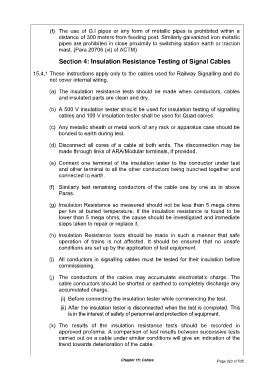Page 372 - IRSEM_Main Book
P. 372
(f) The use of G.I pipes or any form of metallic pipes is prohibited within a
distance of 300 meters from feeding post. Similarly galvanized iron metallic
pipes are prohibited in close proximity to switching station earth or traction
mast. (Para 20706 (vi) of ACTM)
Section 4: Insulation Resistance Testing of Signal Cables
15.4.1 These instructions apply only to the cables used for Railway Signalling and do
not cover internal wiring.
(a) The insulation resistance tests should be made when conductors, cables
and insulated parts are clean and dry.
(b) A 500 V insulation tester should be used for insulation testing of signalling
cables and 100 V insulation tester shall be used for Quad cables.
(c) Any metallic sheath or metal work of any rack or apparatus case should be
bonded to earth during test.
(d) Disconnect all cores of a cable at both ends. The disconnection may be
made through links of ARA/Modular terminals, if provided.
(e) Connect one terminal of the insulation tester to the conductor under test
and other terminal to all the other conductors being bunched together and
connected to earth.
(f) Similarly test remaining conductors of the cable one by one as in above
Paras.
(g) Insulation Resistance so measured should not be less than 5 mega ohms
per km at buried temperature, if the insulation resistance is found to be
lower than 5 mega ohms, the cause should be investigated and immediate
steps taken to repair or replace it.
(h) Insulation Resistance tests should be made in such a manner that safe
operation of trains is not affected. It should be ensured that no unsafe
conditions are set up by the application of test equipment.
(i) All conductors in signalling cables must be tested for their insulation before
commissioning.
(j) The conductors of the cables may accumulate electrostatic charge. The
cable conductors should be shorted or earthed to completely discharge any
accumulated charge.
(i) Before connecting the insulation tester while commencing the test.
(ii) After the insulation tester is disconnected when the test is completed. This
is in the interest of safety of personnel and protection of equipment.
(k) The results of the insulation resistance tests should be recorded in
approved proforma. A comparison of test results between successive tests
carried out on a cable under similar conditions will give an indication of the
trend towards deterioration of the cable.
Chapter 15: Cables Page 320 of 535

